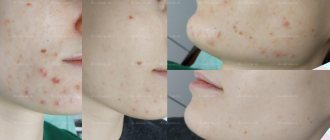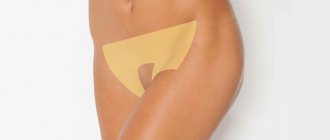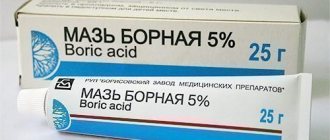Find out more
( 2 ratings, average: 5.00 out of 5)
Recently, many drugs and clinical procedures for the removal of stretch marks have appeared on the market, including both affordable and very expensive. Before considering various remedies for stretch marks, let’s first try to figure out what stretch marks are and why they appear on the body?
Causes of deep stretch marks
Our skin contains fibers consisting of elastin and collagen. If it so happens that a woman suddenly begins to gain weight or, conversely, goes on a strict diet and begins to rapidly lose weight, then the upper layer of skin can still somehow adapt to such changes, but the deeper layer is not so elastic and does not have time to rebuild. Collagen fibers rupture and bright pink or red scars form at the site. Such a bright color is due to the fact that hemorrhage occurs at the site of the rupture. Over time, the color of the furrow lightens and becomes less noticeable.
The main stimulating factors for the occurrence of stretch marks:
- Pregnancy is the most favorable period for the appearance of stretch marks. At first, a woman rapidly gains weight against the background of a hormonal surge, and then just as abruptly loses it. Deep stretch marks appear on the abdomen, thighs, chest and buttocks.
- Treatment with hormones. Hormonal therapy causes fluid retention in the body, body volume increases, the skin stretches, collagen fibers cannot withstand and, as a result, deep stretch marks throughout the body.
- Hormonal changes during puberty and intensive growth.
Ablative and non-ablative fractional lasers for the treatment of stretch marks
For many years, there has been a debate between manufacturers of fractional lasers about the effectiveness of their use for the treatment of stretch marks. Ablative and non-ablative fractional lasers trigger similar biological processes in tissues, which result in remodeling of the skin surface and smoothing of stretch marks. Since striae is a dermal formation, its correction requires thermolysis at the level of the dermis - lasers that reach the depth of the reticular layer of the dermis will be effective. The first, and most important, difference between lasers is the damage or, conversely, preservation of the epidermis. Ablative lasers “evaporate” all cells in their path without exception, and the activity of non-ablative lasers is configured so that only the dermal level is damaged without damaging the surface tissues - the epidermis. Ablative lasers are much more aggressive than non-ablative lasers and have a greater stimulating effect than the latter. Therefore, with all other parameters being equal (depth of exposure, percentage of coverage), an ablative fractional laser will be more effective than a non-ablative one, especially for CO2 lasers. However, the use of ablative lasers in areas where stretch marks are localized is fraught with discomfort and the development of complications. During rehabilitation, which takes from 3 to 5 days, it is necessary to protect the treated surface with a sterile bandage and avoid friction with clothing. The use of ablative fractional lasers on the body - in the abdomen, chest, hips - often ends in the development of post-inflammatory hyperpigmentation - an unpleasant, although temporary, phenomenon. Another disadvantage of fractional ablative lasers, in addition to complex rehabilitation, is rupture of striae due to incorrect procedure technique, which results in the formation of scars. This complication may be due to the fact that ablation microzones formed in the atrophy zone at the site of the striae make it weak to rupture, and subsequent stretching can provoke such a rupture.
RICE. 3. A - BEFORE TREATMENT, B - 2 MONTH AFTER 1 PROCEDURE OF NON-ABLATIVE FRACTIONAL PHOTOTHERMOLYSIS M22‑RESURFX. Photos in Fig. 3 and 4 kindly provided by Dr. E. L. Baranova.
RICE. 4. A - BEFORE TREATMENT, B - 1 MONTH AFTER 1 PROCEDURE OF NON-ABLATIVE FRACTIONAL PHOTOTHERMOLYSIS M22‑RESURFX.
RICE. 5. STREAMS IN THE BREAST AREA. A - BEFORE TREATMENT, B - AFTER 3 PROCEDURES OF NON-ABLATIVE FRACTIONAL PHOTOTHERMOLYSIS M22‑RESURFX. Photo courtesy of Dr. Matteo Tretti Clementoni.
Thus, we can say that non-ablative fractional lasers, despite their lower efficiency compared to ablative ones, are more preferable in the treatment of stretch marks. Classic non-ablative fractional lasers for the treatment of striae are Fraxel 1550 nm and ResurXF 1565 nm (Fig. 3-5). Both of these lasers are capable of creating zones of fractional photothermolysis 1 mm or more deep and are excellent for use on the body as they do not disrupt the skin barrier functions.
How to remove deep stretch marks: options for fighting
Modern doctors are constantly looking for a way that would once and for all rid women of such a problem as deep stretch marks. But a single miraculous method suitable for everyone has not been invented. The fight against deep stretch marks must be approached individually and take into account the characteristics of the body and the reasons for their occurrence.
Modern medicine offers several ways to remove deep stretch marks:
- Cosmetic methods (creams, oils, massages, seaweed wraps, mesotherapy, ozone therapy) can only remove minor external manifestations of stretch marks. Deep stretches are more difficult to deal with using these methods and you need to act comprehensively, using several methods at once.
- Chemical peeling is done using a special acid; it will do a great job of removing stretch marks. The acid penetrates deeply into the skin and burns its deep layers along with stretch marks. This is a very painful and painstaking procedure, equivalent to surgery and is performed under general anesthesia. Rehabilitation lasts several days.
- Laser resurfacing, as well as chemical peeling, is great for treating deep stretch marks. But again, as in the previous case, hospitalization followed by rehabilitation will be needed.
- Plastic surgery is the most radical method of dealing with deep stretch marks. The surgeon simply cuts out an unsightly area of skin.
Combined hardware technique for the treatment of striae IPL+ResurFX+Tripollar
We found that the choice of hardware technique in the treatment of striae is related to the stage of the process, and non-ablative procedures are safer and, as a result, preferable. Based on this, a promising technique is the sequential use of procedures - IPL therapy, non-ablative fractional photothermolysis and multipolar RF lifting. This complex consists of 2 – 3 IPL therapy procedures, which are aimed at treating stretch marks red and are carried out provided that the patient’s body weight is stabilized and the risk of new breaks is minimal. The procedures are performed on the IPL module of the M22 device (Lumenis, Israel), equipped with pulse optimization technology and a set of replaceable light filters that allow you to select the optimal selective effect on the vascular component of striae when treating patients with different phototypes.
Next, a complex of 4 to 7 procedures is applied using the non-ablative fractional laser ResurFX 1565 nm (also a module of the M22 device). These procedures are aimed at smoothing the skin texture and smoothing out stretch marks. They are carried out at intervals of 4 - 5 weeks, their number depends, first of all, on the width of the stretch marks: the narrower the stretch marks, the fewer procedures will be needed. If, in addition to correcting stretch marks, the task is to tighten the skin, which often happens when treating patients recovering from pregnancy or sudden weight loss, then in addition to the course of ResurFX procedures, multipolar RF lifting using TriPollar (Pollogen) technology should be used. The procedures are performed with an interval of 2 weeks, or simultaneously with the procedures on ResurFX. Provided that the patient undergoes the latter every 4 weeks, TriPollar procedures can be performed on him at each such visit, as well as in the intervals between them.
Treatment of skin stretch marks, along with the treatment of scars, is one of the most difficult tasks in therapeutic cosmetology. However, the choice of modern hardware techniques, focused on the clinical manifestations and stages of stretch marks, a combination of these techniques, as well as competent treatment planning can bring significant success.
Prevention of deep stretch marks
The rule “The best treatment is prevention” also applies to deep stretch marks. It is better to take care of the condition of your skin in advance:
- There is no need to experiment with “express diets”. Weight loss should be gradual.
- When carrying a child and after childbirth during lactation, be sure to wear a special support belt and bra.
- Increase skin tone and elasticity. In this case, all methods are good. Use special creams, take a contrast shower, massage and rub to increase blood circulation. Eat right and make sure you take additional vitamins A and E. Jojoba and neroli oils, which need to be rubbed into the skin, provide good prevention against deep stretch marks.
Striae - a cosmetic problem
In the United States, approximately 90% of pregnant women, 70% of teenage girls, and 40% of boys (especially athletes) have stretch marks, according to Medscape.com. These data can be extended to all other countries and races.
Typically, stretch marks are a cosmetic problem, but with a sudden injury or sudden overextension, first tearing, then inflammation and ulceration of the skin are possible.
Striae appear in the form of flat thinning skin of a pink hue, itching from time to time. Gradually, the stretch marks increase in length and width and become reddish-purple (striae rubra). The surface of the striae may become covered with fine wrinkles. Mature striae are white, receding, irregularly shaped stripes, parallel to the lines of skin tension along the long axis, on average several centimeters in length and 1-10 mm in width. Over time, some stretch marks may disappear or become less noticeable. The natural evolution of stretch marks is similar to the formation of scar tissue during wound healing.
During pregnancy, stretch marks usually affect the abdomen and mammary glands. The most common areas with stretch marks in adolescents are located on the outer surfaces of the thighs and lumbosacral region in boys and on the thighs, buttocks, and mammary glands in girls. Less commonly, other areas, such as the upper arms, are affected.
Striae induced by long-term use of systemic steroids are usually longer and wider than other types of stretch marks; damaged areas are also capable of expanding, involving more and more parts of the body, sometimes the face. Stretch marks may occur as a side effect of long-term use of topical corticosteroids under occlusive dressings. This kind of stretch marks occurs in places where bandages are applied and usually goes away on their own after discontinuation of local treatment.
What result to expect
By approaching the question “how to remove deep stretch marks” wisely, having patience and completing the task, you will soon be able to admire your smooth, healthy skin again.
But remember! Once you get rid of deep stretch marks, you are not immune to the fact that they will not appear again. Take care of your body and don't forget to take preventative measures.
Fractional thermolysis against stretch marks: before and after
Laser treatment of stretch marks: before and after
Ekaterina Romanova
Ways to eliminate stretch marks
The fight against stretch marks must be carried out comprehensively. Here are the basic skin care steps that will help correct existing stretch marks and prevent new ones from appearing.
- Exfoliation.
- Massage.
- Moisturizing and strengthening.
We have collected all the necessary tools for you in one set. The complex for correcting stretch marks
includes a dry massage brush, stretch mark oil, raspberry cream scrub and lifting cream.
Let’s take a closer look at effective procedures and products that will help you make stretch marks almost invisible on your own.
Symptoms of stretch marks
Striae in men, adolescents and women have the same appearance. These are always wavy narrow stripes that are localized on the stomach, hips, chest, buttocks and legs, red-bluish or white.
Striae do not lend themselves to tanning. Visually they resemble scars (you can verify this by looking at a photo of stretch marks).
If you experience similar symptoms,
consult your doctor . It is easier to prevent a disease than to deal with the consequences.
Massage
Dry massage with special brushes - drybrushing - gives an excellent result in the fight against stretch marks. With regular use of such brushes, the skin is cleansed of dead particles, becomes smooth and soft, cellulite and stretch marks become less pronounced. The main rule of dry massage is that movements should be in the direction of the lymph: from the feet to the heart.
Dry massage is easy to perform yourself at home - the whole process will take no more than 15 minutes. Brushes make the skin elastic and well-groomed, and also relieve stress, relax muscles and activate recovery processes.
For a massage to be effective, it is important not only to do it correctly, but also to choose a quality brush. ARAVIA accessories are made of beech wood and natural bristles. Natural materials will make the procedure tactilely pleasant, and the long handle will allow you to work on hard-to-reach areas.
Brushes vary in degree of hardness:
- soft, suitable for beginners and those with sensitive skin;
- The medium one will appeal to those who have already tried drybrushing and want a more intense effect on the skin.
Remember: any massage technique requires prior consultation with a specialist.
How to prevent the appearance of stretch marks on the skin?
During pregnancy, it is important to follow the principles of prevention that will protect the skin from stretch marks. First, you need to add foods rich in vitamin E and C to the pregnant woman’s diet. Legumes are rich in vitamins and minerals, as well as green vegetables. You should give up sugar, it reduces the formation of collagen in the skin.
It is also necessary to monitor your water balance. If the pregnant woman is not bothered by body edema and there are no special recommendations from the supervising doctor, it is recommended to drink at least 1.5 liters of water per day. It is also necessary to monitor the nutrition of the skin, moisturize it with special creams and lotions, and use a hard-bristled brush when washing.
Moderate physical activity increases muscle tone. For this purpose there are special group classes in the gym. Women during pregnancy usually practice yoga. If physical exercise is contraindicated for health reasons, you should spend more time walking at a brisk pace.
What to do if you already have stretch marks? How to get rid of stretch marks?
You can get rid of stretch marks after childbirth or those that arise for another reason in the most reliable way, which is offered by our specialists. This is laser removal, as a result of which the skin is tightened, and the stretch marks themselves become smaller and gradually smooth out.
To do this, we use an effective and safe Palomar device with a 15.40 nozzle. The laser beam does not affect healthy tissue, but only affects the treatment area.
The number of sessions depends on the size of the stretch marks and how long ago you have had them. On average, you will need approximately 4-5 sessions with an interval of 3-4 weeks. To get rid of a small stretch mark up to 0.3 cm in size, just one session is enough.
The important thing is that 1 session reduces the width of the stretch by 20%.

![Table 2. Glucocorticosteroid preparations for local use in the treatment of rhinitis [7, 8] Table 2. Topical corticosteroids for rhinitis [7, 8]](https://dlradio.ru/wp-content/uploads/tablica-2-preparaty-glyukokortikosteroidov-dlya-mestnogo-primeneniya-pri-lechenii-rinita-330x140.jpg)







